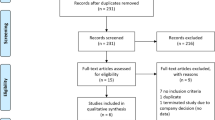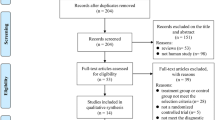Abstract
Purpose
Several studies have explored the impact of non-steroidal anti-inflammatory drugs (NSAIDs) and the risk of Parkinson disease (PD). However, the extent to which NSAIDs may increase or decrease the risk of PD remains unresolved. We, therefore, performed a meta-analysis of relevant studies to quantify the magnitude of the association between NSAID use and PD risk in the elderly population.
Methods
The electronic databases such as PubMed, EMBASE, Scopus, Google Scholar, and Web of Science were used to search the relevant articles published between January 1990 and December 2017. Large (n ≥ 1000) observational design studies with a follow-up at least 1 year were considered. Two authors independently extracted information from the included studies. Random effect model was used to calculate risk ratios (RRs) with 95% confidence interval (Cl).
Results
A total of 17 studies with 2,498,258 participants and nearly 14,713 PD patients were included in the final analysis. The overall pooled RR of PD was 0.95 (95%CI 0.860–1.048) with significant heterogeneity (I2 = 63.093, Q = 43.352, p < 0.0001). In the subgroup analysis, the overall pooled RR of PD was 0.90 (95%CI 0.738–1.109), 0.96 (95%CI 0.882–1.055), and 0.99 (95%CI 0.841–0.982) from the studies of North America, Europe, and Asia. Additionally, long-term use, study design, individual NSAID use, and risk of PD were also evaluated.
Conclusion
Despite the neuroprotective potential of NSAIDs demonstrated in some experimental studies, our findings suggest that there is no association between NSAIDs and the risk of Parkinson disease at the population level. Until further evidence is established, clinicians need to be vigilant ensuring that the use of NSAIDs remains restricted to their approved anti-inflammatory and analgesic effect.




Similar content being viewed by others
References
Poly TN, Islam MM, Walther BA, Yang H-C, Nguyen P-A, Huang C-W, Shabbir S-A, Li Y-CJ (2017) Exploring the association between statin use and the risk of Parkinson’s disease: a meta-analysis of observational studies. Neuroepidemiology 49:142–151
Le W, Wu J, Tang Y (2016) Protective microglia and their regulation in Parkinson’s disease. Front Mol Neurosci 9:89
Solomon DH, Cannon CP, Saperia GM (2014) Nonselective NSAIDs: adverse cardiovascular effects
Kurth T, Hennekens CH, Buring JE, Gaziano JM (2004) Aspirin, NSAIDs, and COX-2 inhibitors in cardiovascular disease: possible interactions and implications for treatment of rheumatoid arthritis. Curr Rheumatol Rep 6:351–356
Hennekens CH, Knatterud GL, Pfeffer MA (2004) Use of aspirin to reduce risks of cardiovascular disease in patients with diabetes: clinical and research challenges. Diabetes Care 27:2752–2754
Teismann P, Ferger B (2001) Inhibition of the cyclooxygenase isoenzymes COX-1 and COX-2 provide neuroprotection in the MPTP-mouse model of Parkinson’s disease. Synapse 39:167–174
Chen H, Jacobs E, Schwarzschild MA, McCullough ML, Calle EE, Thun MJ, Ascherio A (2005) Nonsteroidal antiinflammatory drug use and the risk for Parkinson’s disease. Ann Neurol 58:963–967
Bornebroek M, De Lau LM, Haag MD, Koudstaal PJ, Hofman A, Stricker BH, Breteler MM (2007) Nonsteroidal anti-inflammatory drugs and the risk of Parkinson disease. Neuroepidemiology 28:193–196
Gao X, Chen H, Schwarzschild MA, Ascherio A (2011) Use of ibuprofen and risk of Parkinson disease. Neurology 76:863–869
Hirsch EC, Vyas S, Hunot S (2012) Neuroinflammation in Parkinson’s disease. Parkinsonism Relat Disord 18:S210–S212
Maharaj D, Saravanan K, Maharaj H, Mohanakumar K, Daya S (2004) Acetaminophen and aspirin inhibit superoxide anion generation and lipid peroxidation, and protect against 1-methyl-4-phenyl pyridinium-induced dopaminergic neurotoxicity in rats. Neurochem Int 44:355–360
Aubin N, Curet O, Deffois A, Carter C (1998) Aspirin and salicylate protect against MPTP-induced dopamine depletion in mice. J Neurochem 71:1635–1642
Sairam K, Saravanan KS, Banerjee R, Mohanakumar KP (2003) Non-steroidal anti-inflammatory drug sodium salicylate, but not diclofenac or celecoxib, protects against 1-methyl-4-phenyl pyridinium-induced dopaminergic neurotoxicity in rats. Brain Res 966:245–252
Przybyłkowski A, Kurkowska-Jastrzebska I, Joniec I, Ciesielska A, Członkowska A, Członkowski A (2004) Cyclooxygenases mRNA and protein expression in striata in the experimental mouse model of Parkinson’s disease induced by 1-methyl-4-phenyl-1, 2, 3, 6-tetrahydropyridine administration to mouse. Brain Res 1019:144–151
Bower J, Maraganore D, Peterson B, Ahlskog J, Rocca WA (2006) Immunologic diseases, anti-inflammatory drugs, and Parkinson disease: a case-control study. Neurology 67:494–496
Samii A, Etminan M, Wiens MO, Jafari S (2009) NSAID use and the risk of Parkinson’s disease. Drugs Aging 26:769–779
Gagne JJ, Power MC (2010) Anti-inflammatory drugs and risk of Parkinson disease a meta-analysis. Neurology 74:995–1002
Liberati A, Altman DG, Tetzlaff J, Mulrow C, Gøtzsche PC, Ioannidis JP, Clarke M, Devereaux PJ, Kleijnen J, Moher D (2009) The PRISMA statement for reporting systematic reviews and meta-analyses of studies that evaluate health care interventions: explanation and elaboration. PLoS Med 6:e1000100
Higgins JP, Green S (2005) Cochrane handbook for systematic reviews of interventions. version
Higgins JP, Thompson SG, Deeks JJ, Altman DG (2003) Measuring inconsistency in meta-analyses. BMJ 327:557–560
Islam MM, Iqbal U, Walther B, Atique S, Dubey NK, Nguyen P-A, Poly TN, Masud JHB, Li Y-CJ, Shabbir S-A (2016) Benzodiazepine use and risk of dementia in the elderly population: a systematic review and meta-analysis. Neuroepidemiology 47:181–191
Becker C, Jick S, Meier C (2011) NSAID use and risk of Parkinson disease: a population-based case-control study. Eur J Neurol 18:1336–1342
Chen H, Zhang SM, Hernán MA, Schwarzschild MA, Willett WC, Colditz GA, Speizer FE, Ascherio A (2003) Nonsteroidal anti-inflammatory drugs and the risk of Parkinson disease. Arch Neurol 60:1059–1064
Driver JA, Logroscino G, Lu L, Gaziano JM, Kurth T (2011) Use of non-steroidal anti-inflammatory drugs and risk of Parkinson’s disease: nested case-control study. Bmj 342:d198
Etminan M, Carleton BC, Samii A (2008) Non-steroidal anti-inflammatory drug use and the risk of Parkinson disease: a retrospective cohort study. J Clin Neurosci 15:576–577
Etminan M, Suissa S (2006) NSAID use and the risk of Parkinson’s disease. Curr Drug Saf 1:223–225
Hancock DB, Martin ER, Stajich JM, Jewett R, Stacy MA, Scott BL, Vance JM, Scott WK (2007) Smoking, caffeine, and nonsteroidal anti-inflammatory drugs in families with Parkinson disease. Arch Neurol 64:576–580
Hernán MA, Logroscino G, Rodríguez LAG (2006) Nonsteroidal anti-inflammatory drugs and the incidence of Parkinson disease. Neurology 66:1097–1099
Lin CH, Wu RM, Chang HY, Chiang YT, Lin HH (2013) Preceding pain symptoms and Parkinson’s disease: a nationwide population-based cohort study. Eur J Neurol 20:1398–1404
Manthripragada AD, Schernhammer ES, Qiu J, Friis S, Wermuth L, Olsen JH, Ritz B (2011) Non-steroidal anti-inflammatory drug use and the risk of Parkinson’s disease. Neuroepidemiology 36:155–161
Powers KM, Kay DM, Factor SA, Zabetian CP, Higgins DS, Samii A, Nutt JG, Griffith A, Leis B, Roberts JW (2008) Combined effects of smoking, coffee, and NSAIDs on Parkinson’s disease risk. Mov Disord 23:88–95
Sung Y-F, Liu F-C, Lin C-C, Lee J-T, Yang F-C, Chou Y-C, Lin C-L, Kao C-H, Lo H-Y, Yang T-Y (2016) Reduced risk of Parkinson disease in patients with rheumatoid arthritis: a nationwide population-based study. Mayo Clinic Proceedings. Elsevier, pp 1346–1353
Ton TG, Heckbert SR, Longstreth W, Rossing MA, Kukull WA, Franklin GM, Swanson PD, Smith-Weller T, Checkoway H (2006) Nonsteroidal anti-inflammatory drugs and risk of Parkinson’s disease. Mov Disord 21:964–969
Wahner AD, Bronstein JM, Bordelon YM, Ritz B (2007) Nonsteroidal anti-inflammatory drugs may protect against Parkinson disease. Neurology 69:1836–1842
Kurkowska-Jastrzębska I, Babiuch M, Joniec I, Przybyłkowski A, Członkowski A, Członkowska A (2002) Indomethacin protects against neurodegeneration caused by MPTP intoxication in mice. Int Immunopharmacol 2:1213–1218
Mohanakumar KP, Muralikrishnan D, Thomas B (2000) Neuroprotection by sodium salicylate against 1-methyl-4-phenyl-1, 2, 3, 6-tetrahydropyridine-induced neurotoxicity. Brain Res 864:281–290
Eccleston C, Cooper TE, Fisher E, Anderson B, Wilkinson NM (2017) Non-steroidal anti-inflammatory drugs (NSAIDs) for chronic non-cancer pain in children and adolescents. Cochrane Database Syst Rev
Teismann P, Tieu K, Choi D-K, Wu D-C, Naini A, Hunot S, Vila M, Jackson-Lewis V, Przedborski S (2003) Cyclooxygenase-2 is instrumental in Parkinson’s disease neurodegeneration. Proc Natl Acad Sci 100:5473–5478
Sánchez-Pernaute R, Ferree A, Cooper O, Yu M, Brownell A-L, Isacson O (2004) Selective COX-2 inhibition prevents progressive dopamine neuron degeneration in a rat model of Parkinson’s disease. J Neuroinflammation 1:6
Wang T, Pei Z, Zhang W, Liu B, Langenbach R, Lee C, Wilson B, Reece JM, Miller DS, Hong J-S (2005) MPP+-induced COX-2 activation and subsequent dopaminergic neurodegeneration. FASEB J 19:1134–1136
Carrasco E, Casper D, Werner P (2005) Dopaminergic neurotoxicity by 6-OHDA and MPP+: differential requirement for neuronal cyclooxygenase activity. J Neurosci Res 81:121–131
Sostres C, Gargallo CJ, Arroyo MT, Lanas A (2010) Adverse effects of non-steroidal anti-inflammatory drugs (NSAIDs, aspirin and coxibs) on upper gastrointestinal tract. Best Pract Res Clin Gastroenterol 24:121–132
Bessone F (2010) Non-steroidal anti-inflammatory drugs: what is the actual risk of liver damage? World J Gastroenterol: WJG 16:5651–5661
Funding
This work was financially supported by the “TMU Research Center of Cancer Translational Medicine” from The Featured Areas Research Center Program within the framework of the Higher Education Sprout Project by the Ministry of Education (MOE) in Taiwan.
Author information
Authors and Affiliations
Corresponding author
Ethics declarations
Conflict of interest
The authors declare that they have no conflict of interest.
Ethical standard
This study has been approved by our Institution’s Ethics Committee and has, therefore, been performed in accordance with the ethical standards laid down in the 1964 Declaration of Helsinki.
Electronic supplementary material
ESM 1
(DOCX 209 kb)
Rights and permissions
About this article
Cite this article
Poly, T.N., Islam, M.M.(., Yang, HC. et al. Non-steroidal anti-inflammatory drugs and risk of Parkinson’s disease in the elderly population: a meta-analysis. Eur J Clin Pharmacol 75, 99–108 (2019). https://doi.org/10.1007/s00228-018-2561-y
Received:
Accepted:
Published:
Issue Date:
DOI: https://doi.org/10.1007/s00228-018-2561-y




